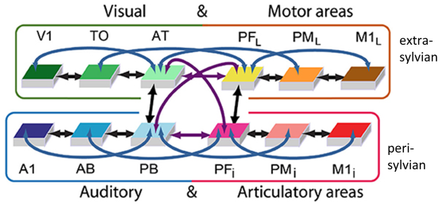
Connectivity structure of the brain constrained neural network used in MatCo.
One of the brain-constrained models used in the MatCo project consists of twelve cortical areas. The perisylvian language network is represented by three auditory (primary auditory cortex, auditory belt, modality-general parabelt) and three articulatory areas (primary motor cortex, inferior premotor cortex, multimodal prefrontal motor cortex). In addition to the perisylvian language network, we model several extrasylvian sensorimotor and connector hub areas that have been shown to contribute to language processing: three visual (primary visual cortex, temporo-occipital areas, anterior-temporal areas) and three motor areas (lateral primary motor cortex, premotor cortex, prefrontal cortex).
As can be seen in the diagram on the top left, the areas are connected with each other. Existing anatomical pathways in the brain provide one of the constraints determining network structure. The between-area connections include direct next-neighbor connections (black arrows), links between second-next neighbors or 'jumping links' (blue arrows) and long-distance cortico-cortical connections (purple arrows).